Galactic Cruise review — Intergalactic masterpiece

Sometimes a game comes along that hits for you on all levels. Even after getting crushed by other players in my first playthrough, I was ready to get the game back to the table. In the second game, everything meshed and I was able to dominate the table. In game three, my wife got the win, with a little help from me, and was ready to play again. Every time this game ended, the players were ready to set up again.
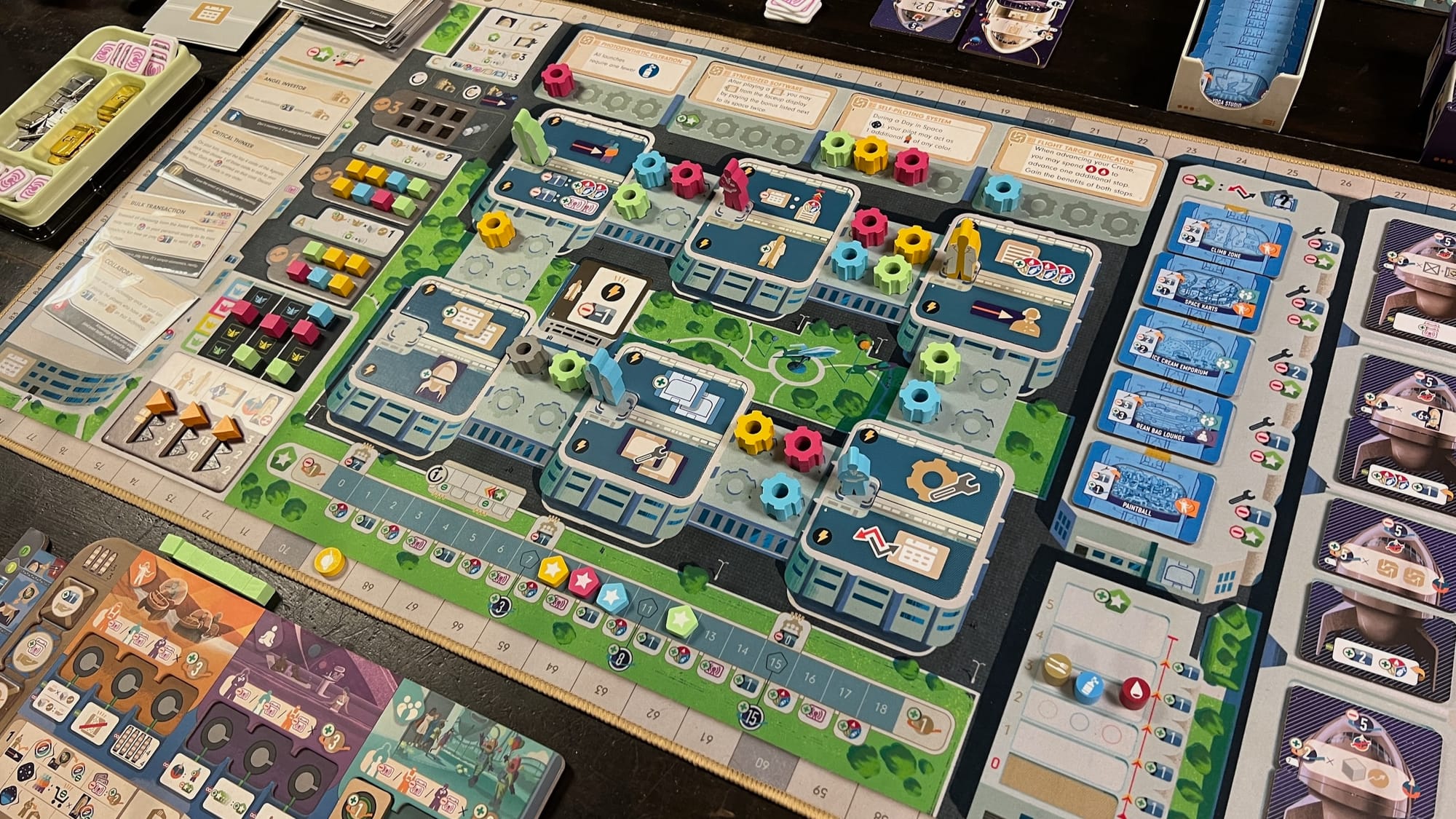
Galactic Cruise is the sophomore masterpiece from Kinson Key Games and designers T.K. King, Dennis Northcutt, and Koltin Thompson. The game supports 1-4 players and is a medium heavy game, with a load of mechanisms built in such as worker placement, multi-use cards, tableau building, and resource management. In Galactic Cruise, the owner of an intergalactic cruise company is retiring and looking for his successor. Your goal is to show the boss that you are the most effective and profitable cruise director out there by building your own fleet of ships and getting people to take a cruise. At the end of three variable rounds, the player with the most points will become the new CEO of the company.
Gameplay
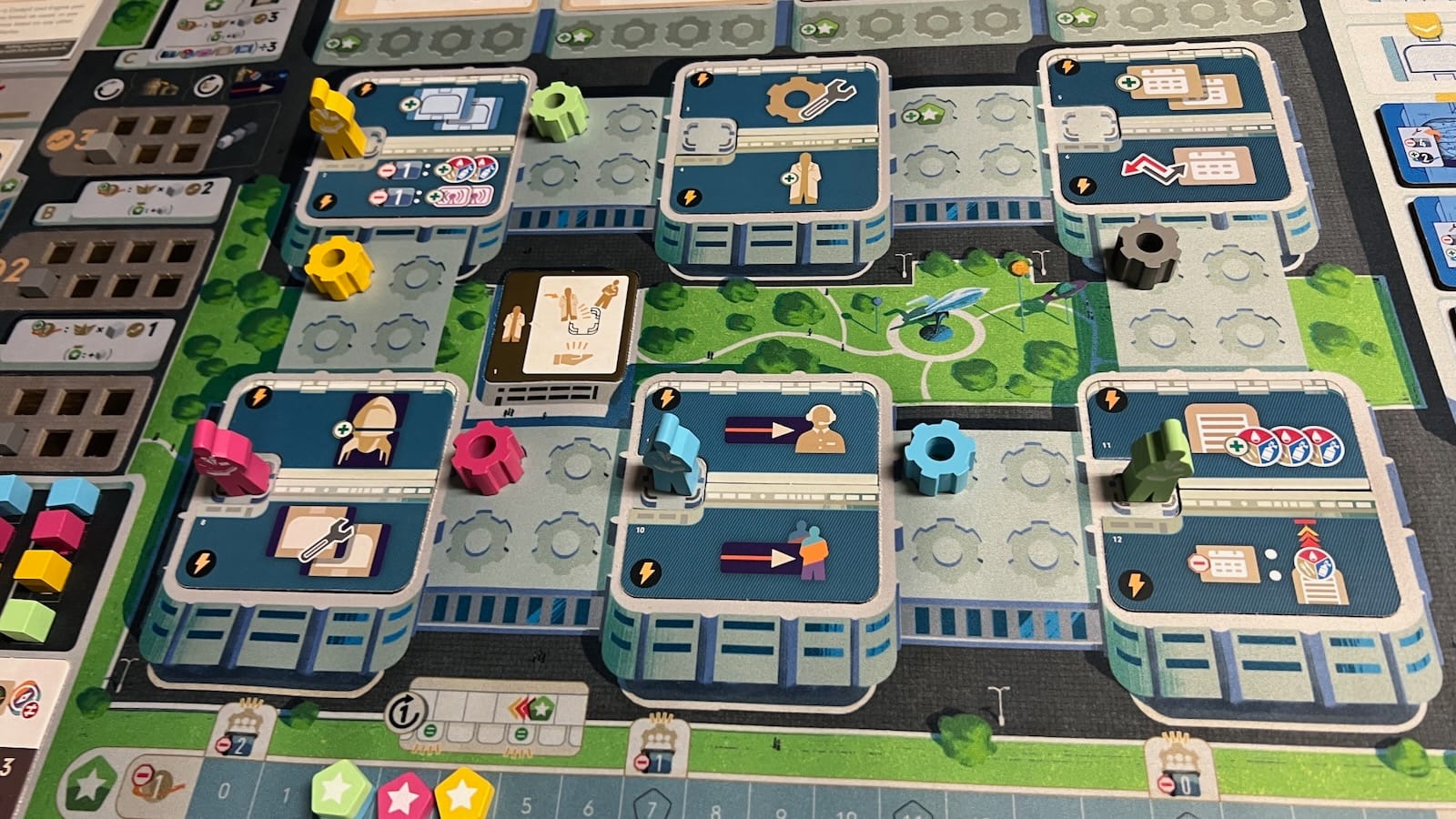
The overall goal for the players is launching cruises with amenities for the three different types of passengers: Families, Adverturists, and Leisure. Without any upgrades, players can build up three cruise ships with different cabins and rooms catering to the guests. Each cruise also needs fuel, oxygen, and food to get through the planned itineraries. Players also have to market the cruises to entice the right type of guests that will enjoy their curated cruise ships.
To do all this, players will start with two workers. On a turn, players have the option to place one of their workers on an action space and utilize the two options available. If another player’s pawn is in a spot they want to go, then they bump that worker back to their opponent’s board. Players can also use other players’ developments or develop on their own to use adjacent action spaces. Of course, using another player’s ingenuity comes at a financial cost. These action spaces will help the player work their way towards building and launching their cruise ships. For example, players will utilize one action space to collect blueprints for different modules on their cruises while building the modules utilizes another action space and, of course, money. Players have opportunities to collect resources from the company silo, draft agenda cards that can be used as resources or to enhance different actions in the game, and even higher advanced workers that come with special abilities. If a player is out of workers, they have to call a meeting to regroup on the player board. Every time a player worker returns back to the board, they will gain one of four income bonuses per worker. Calling a meeting also gives players an action of their choice, depending on their development markers on the board.
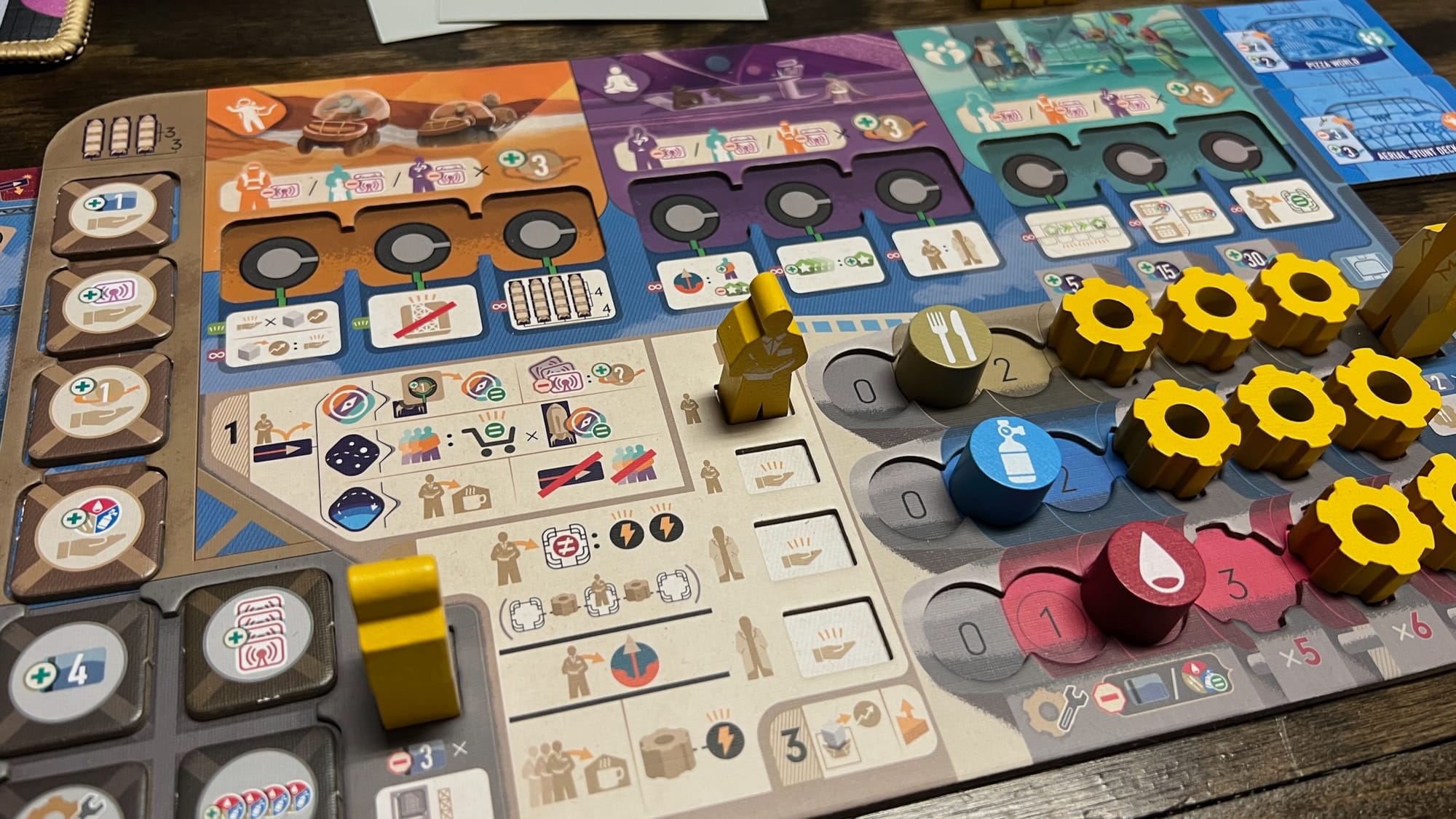
When a cruise is ready to launch, players will have built modules and cabins, booked an itinerary, sold tickets to guests (or recruited a few last minute passengers), paid the correct resources, and loaded some bonus cargo onboard. While a cruise is in space, at the beginning of their turn players will advance their cruises along the itinerary. If spending a day in space, passengers will enjoy amenities associated with their type and give players bonuses. When visiting a location, players can spend advertisement tokens to score points and drop off their cargo to upgrade their abilities in the rest of the game. Happy passengers can score big bonus points on these cruises.
As ships launch and different in-game conditions are met, cubes of the player color are added to a display. The first two times the display is filled, a mid-game scoring round is executed. After the third display is filled, the game end is triggered. Players will get a few more opportunities to take turns and advance cruises until final scoring is tabulated. Players will score points based on their ship cockpit bonuses, printed scoring on player boards, influence tracks, and built modules, the number of leftover resources, and the cubes placed in the display. The winner becomes the new CEO of the company.
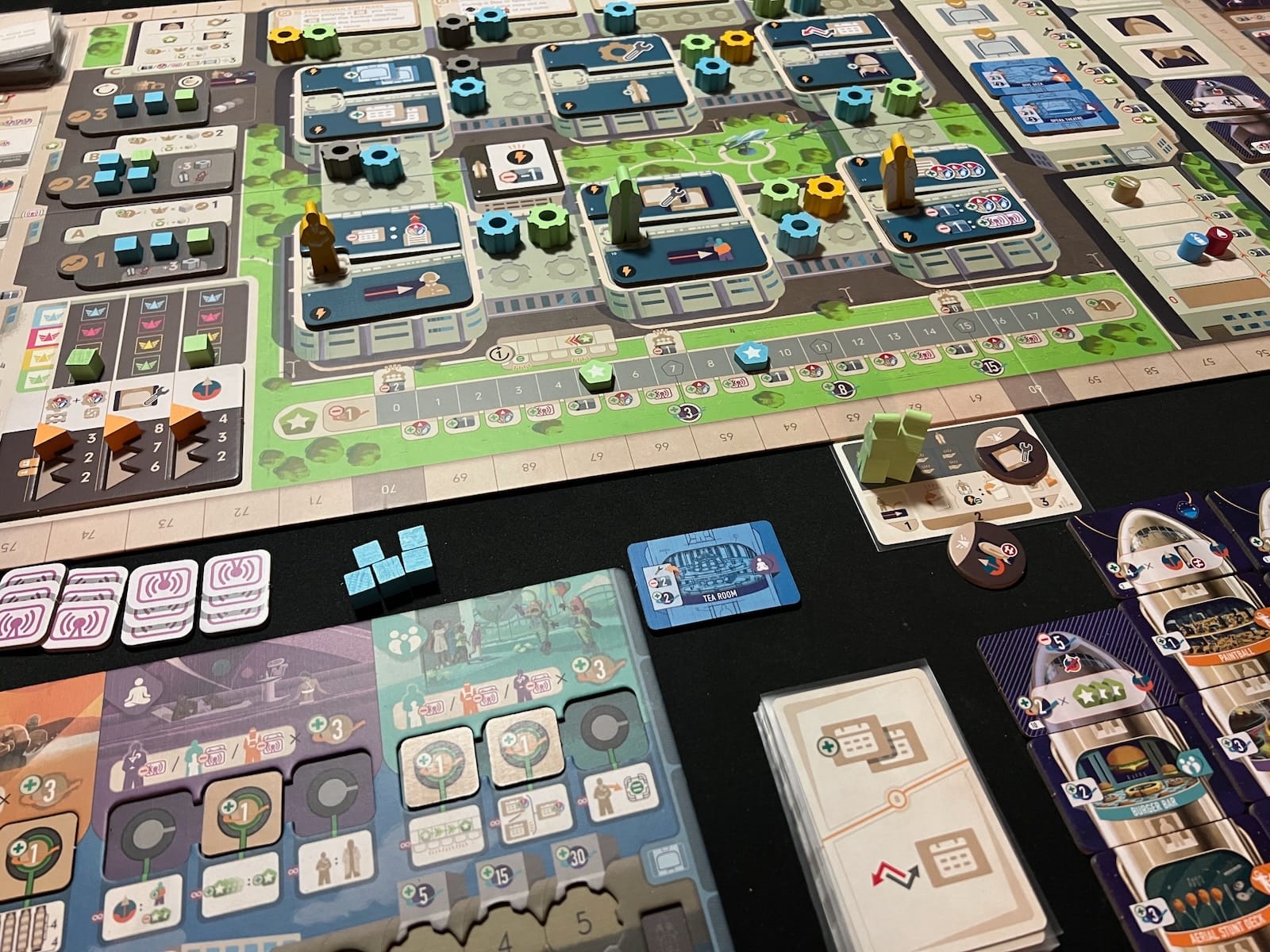
The game seems to have a lot of components and mechanisms at first glance – and at second glance – but the thing is that they all marry together so well. There were very few times in any given game where you might feel stuck, because there is always something to do. By bumping players, the only places off limits would be where one of your other works may be, but then you can go to an adjacent location and utilize a development to take the action anyway. The introductory game set up makes most action spaces symbiotic, with one complementing the other. In a standard game, there is no promise of symbiosis and with 12 different action spaces, the randomized possibilities are endless. Combine the randomized scoring goal tiles, advanced worker abilities, and technology upgrade tiles and the sheer amount of random replayability is endless. This also means that one strategy isn’t going to overpower the others every game. Players will need to adapt to a new board state every single time they set up the game. Managing card abilities and upgrades is crucial and may shift importance depending on the way the board is playing each game.
2 Player Variation
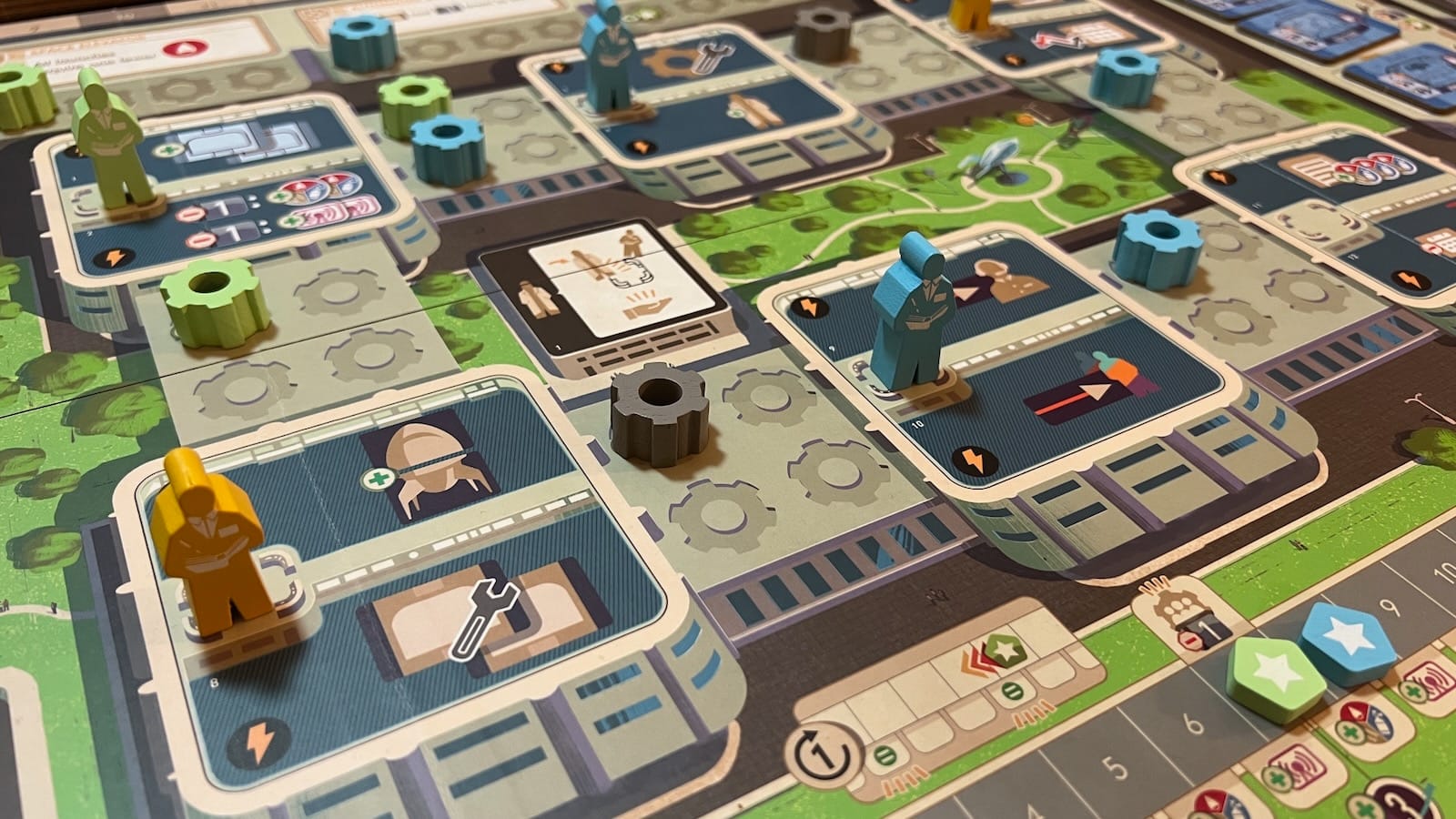
During set-up, overlays are used that require less player cubes to advance the game, and in the 2-player variant a third player’s workers and developments are introduced to the game. On the back of each of the technology tiles are randomized marker placement used during game set-up. After each of the mid-game scoring phases, one of these technology tiles is flipped and three developments are added to the board in the unused player color. At the start of the game, the two basic workers are placed on the board that can be bumped around the action spaces, potentially bumping other workers back to the home board. During the scoring phases, these workers are upgraded to their more advanced counterparts.
The two player variation played just as well as the 3-4 player counts. The addition of the extra player pieces helped give the feel of a larger player count and allowed for some bumping of workers. Without the changes, there would be a ton of meetings called versus the natural bumping that happens with more players.
Solo Mode
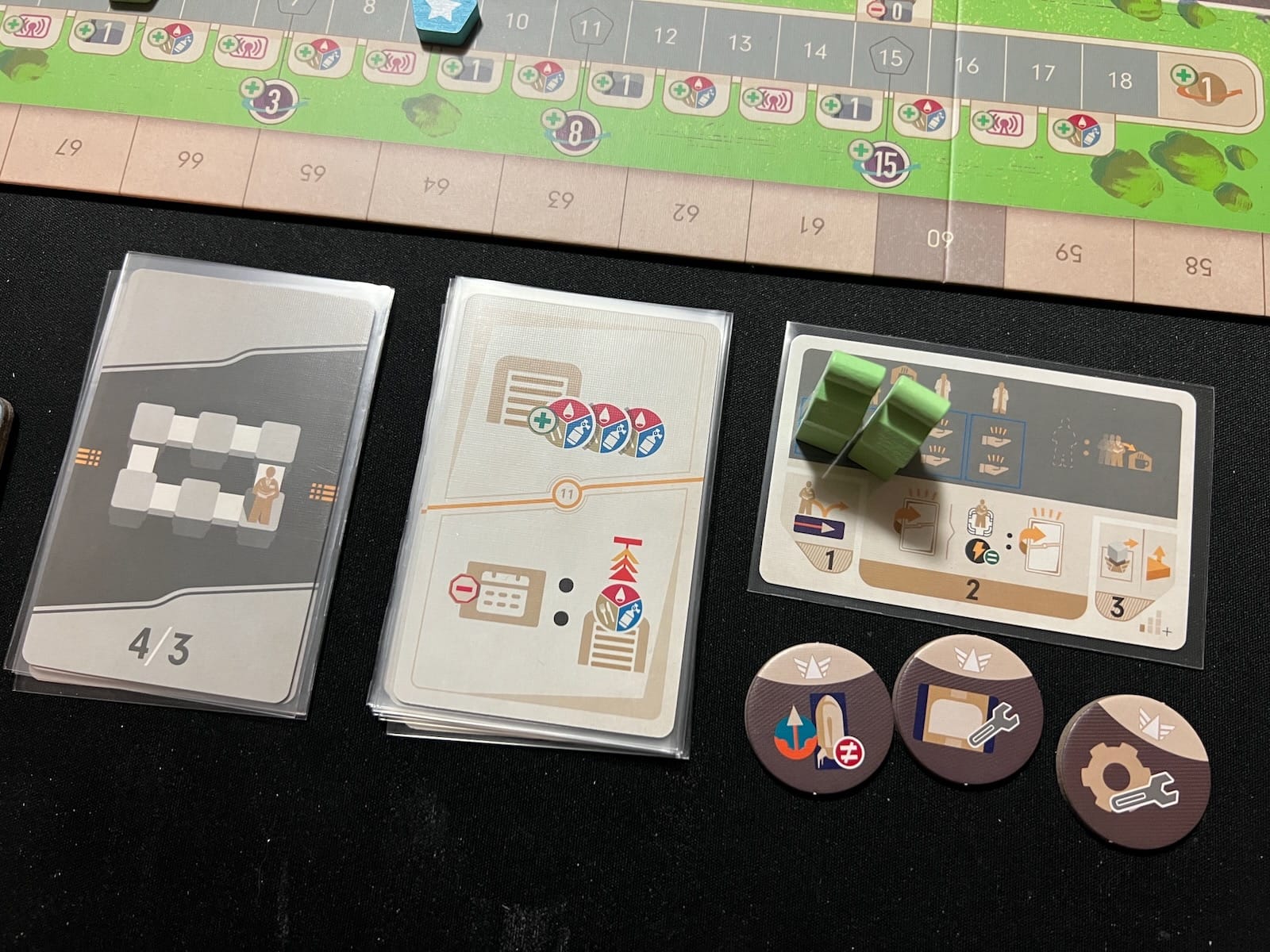
In the solo mode, you are taking on Rachel, a long lost family member who has been biding their time off planet but returned to take their rightful place at the head of the company. This opponent can be scaled to an easy, medium, or hard difficulty. Rachel has three scoring markers that are placed on different locations, depending on the difficulty which include developments built, cabins constructed, and ships launched. Rachel will also execute the actions differently depending on how tough you make her.
Rachel uses a deck of cards to play the game that serves two purposes. One side of the card features a grid featuring a worker location and two numbers. The numbers help Rachel make decisions at various places on the board. The other side of the cards feature actions Rachel will take on her turn. Depending on the difficulty chosen for the game, Rachel will take one of the actions of the card, or utilize the network and take multiple actions. Rachel does not use resources in the same way as players and will have modified actions. Rachel also has special conditions to launch ships and place cubes on the timing track.
The solo mode is well balanced and pretty easy to execute. After my first game, I rarely referenced the rulebook once learning how she interacted with the game. Each difficulty level felt like I was playing a real player which is my preferred solo mode. Combine the difficulty rating with the sheer mass amount of set-up variability and I could play this again and again and again.
Production
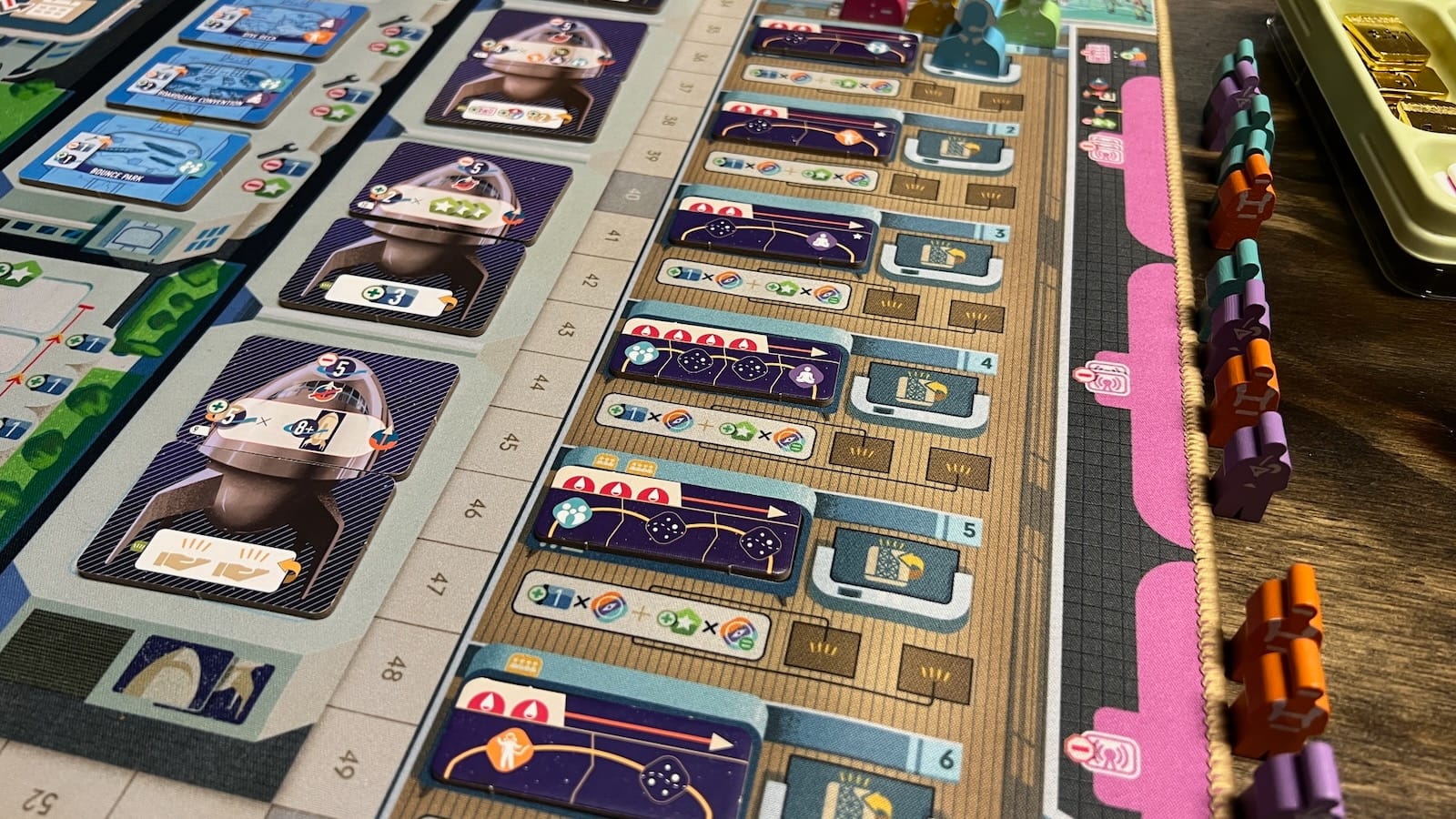
This game set a very high bar for games going forward and maybe even a new standard. I have been lucky to play a friend’s kickstarter decked out version and the base game provided by Kinson Key Games and I was shocked to find how much the base game was similar to the bling.
The main board can be used on both sides, one for the intro game already printed and the other for the standard set-up. The cardboard components in the game are thick and have a great feel on the board and the table. Most of the player components are made of a thick bright colored wood with my only complaint being the blue character pieces being so similar to the family passenger tokens. The player boards are dual layered and can suffer from the warping common with the style. I found however that after warping, the boards returned to their fantastically flat state.
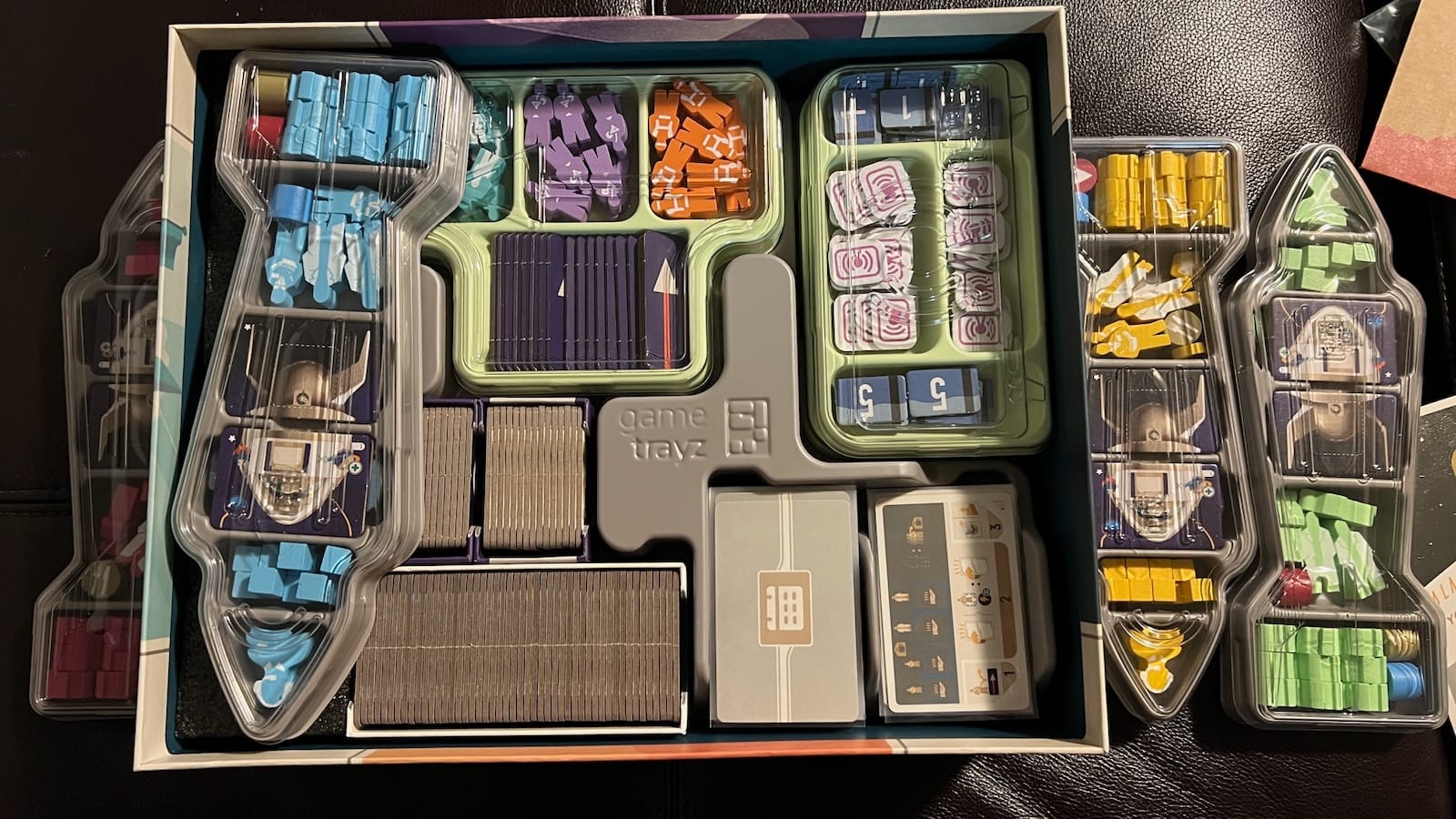
Kinson Key also had some big name partnerships on the production team. The entire game is loaded with the artwork of Ian O’Toole who illustrated everything in a mid-21st century modern Tomorrowland style. The developers also partnered with GameTrayz, whose components come standard in the base box. Each player has its own container for all the pieces they need and the passenger and itinerary tiles fit into another. Even the advertisement and money tiles get two containers of their own. Everything fits like a glove and even has room for the expansion content being released at the same time as the base game.
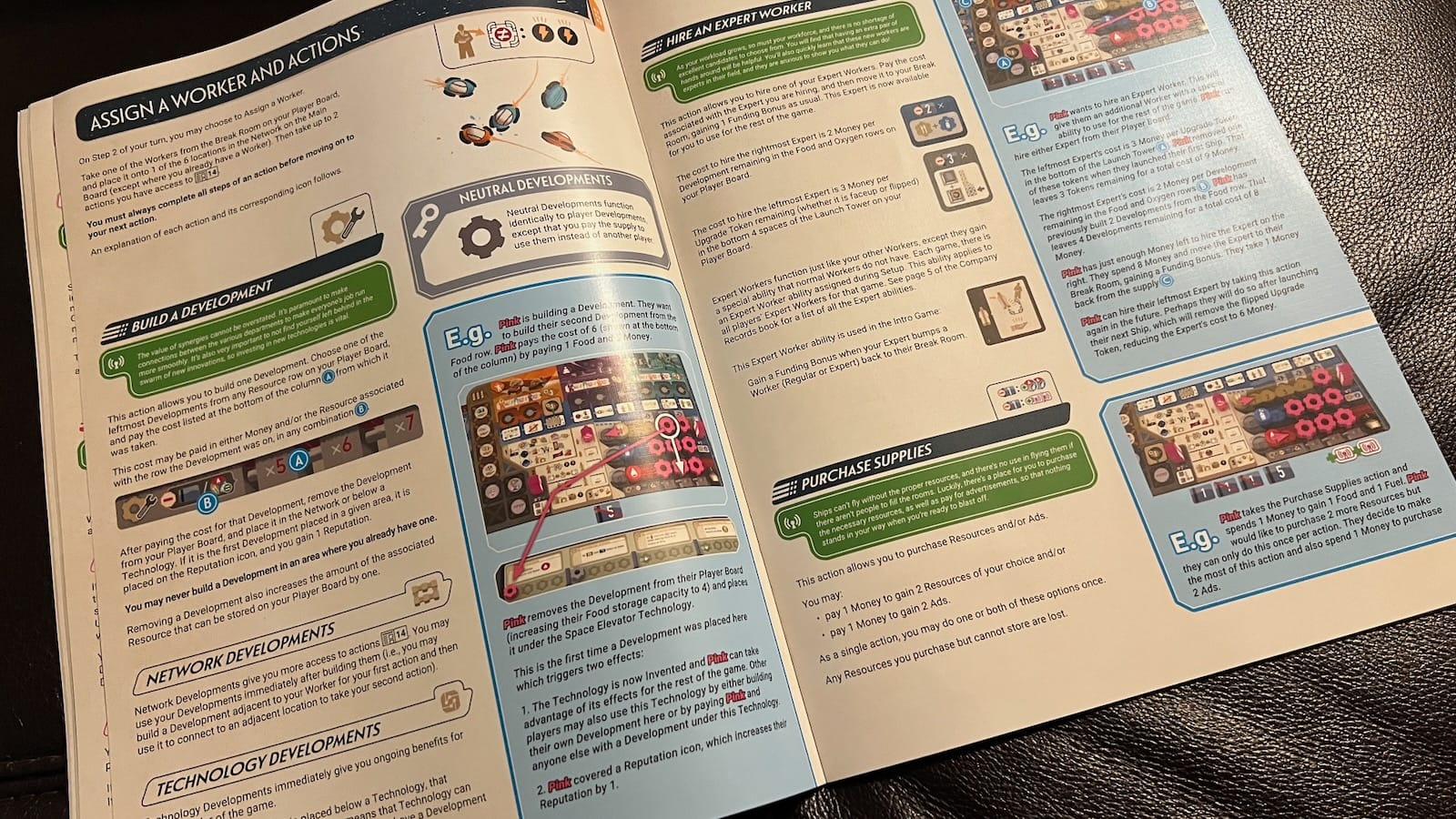
The player aids, rule book, and appendix booklet are masterpieces in user experience and design and a huge kudos goes out to Ammon Anderson who developed them. The rule book is easy to read and flows nicely. Each section has a fleshed out example to go with it and references to other pages when referencing other content. The creators also knew that players would love the game enough and added the expansion rules to the main rulebook. The Player Aid booklets feature the information most useful to players such as actions, scoring goals, and everything they need to execute a turn or a launch. The player aid also features references to page numbers in the player manual throughout. The Company Records appendix book adds a few more references, some game variants, and even space to add future expansion content.
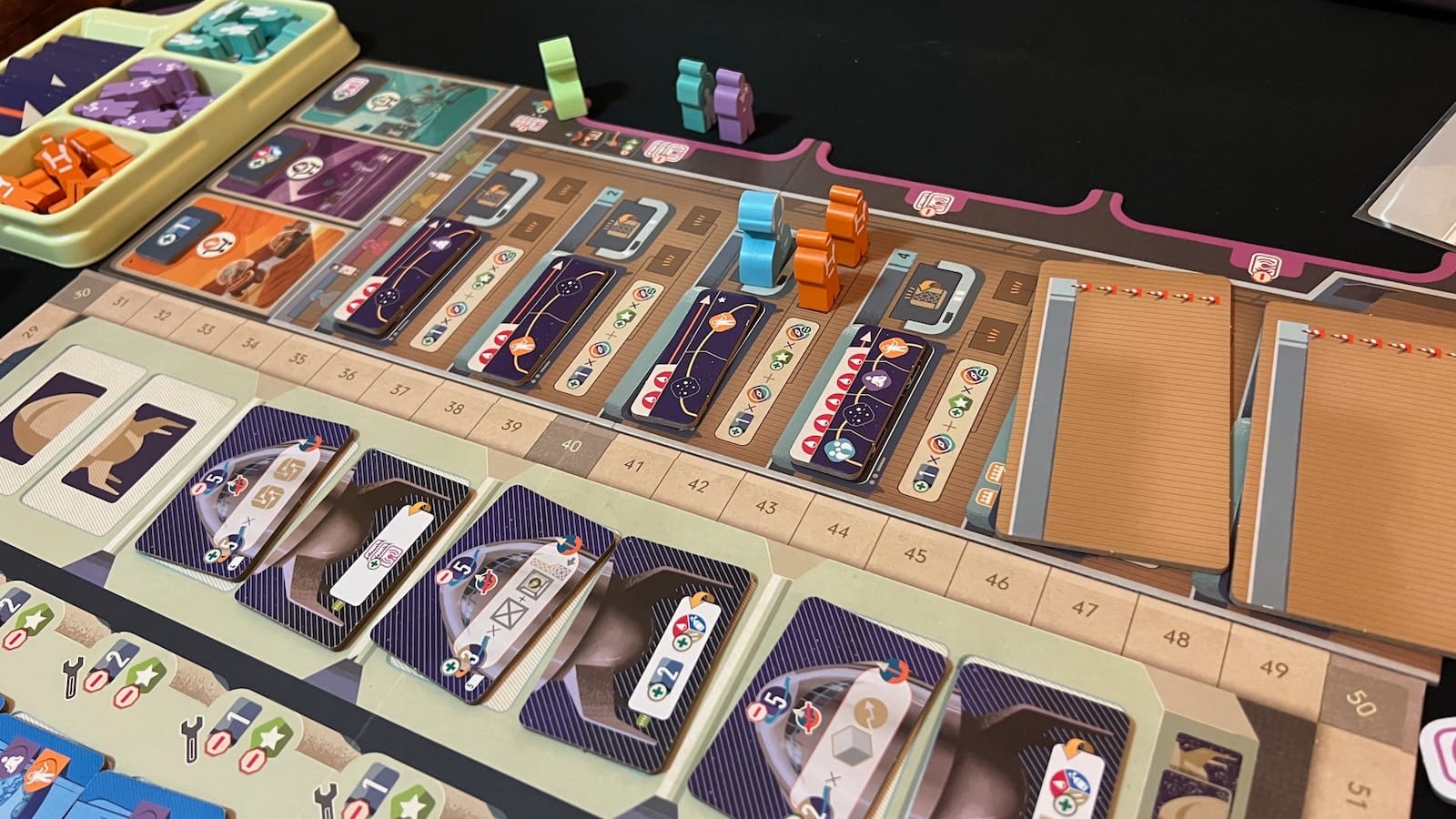
Though Kinson Key only sent us the base game, I would be remiss to mention the upgraded content I got to use as well. Players can buy upgraded advertisement and money tiles, sleeves for the different cards, and even a player mat that greatly improves the experience. In the base game, the randomized tile elements sit on top of the board which could move as players interact with the board during their turns. The mat has cut outs allowing the action, technology, and scoring tiles to be slotted into the mat and allowing a smoother gaming experience. There are also two expansions currently available to add even more gameplay content that I will be getting my hands on as soon as I possibly can.
Overall Thoughts
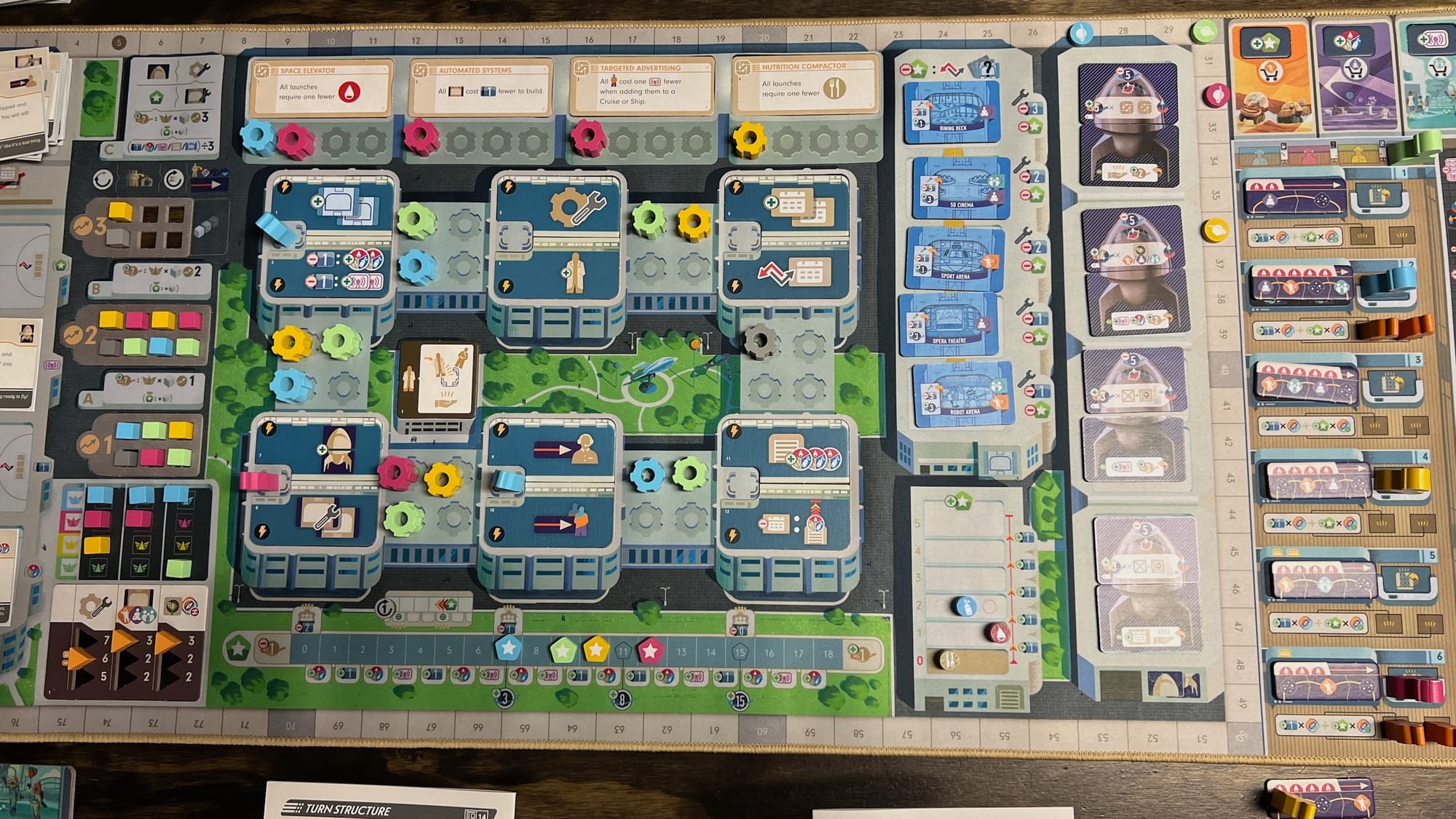
Galactic Cruise is one of the best gaming experiences I have had in a long time. The production absolutely blew me away with practical places for every single element in the game and the great GameTrayz components. The gameplay is very intuitive and I never once felt like I had nothing to do on my turn. Even if I ran into a situation where I couldn’t do exactly what I wanted, I could still pivot and feel like I was moving forward. The introductory game is a fantastic on-ramp experience, but the standard game gives you a different experience every time you set it up. The way the standard game is set-up, the amount of different combinations the tiles can go on the board will force players to adjust their strategy to the puzzle on the board. The game plays great at every player count and the NPC element added to the 2-Player game can easily be added into the 3-Player game to add more variety. Right now, Galactic Cruise is my game of the year, and I don’t see much competing with it.
Review Guidelines
Phenomenal
Galactic Cruise is a fantastic gaming experience that combines beautiful design, strategic gameplay, and hours of variability in a well packed box. The game begs to be played again and again.
Pros
- Strategic, variable gameplay
- Beautifully designed components from storage to artwork
- The desire to play again immediately after finishing a game
Cons
- Some warping on the dual layer player boards
- Blue player components and family pawns are similar colors
- The desire to play again immediately after finishing a game
This review is based on a retail copy provided by the publisher.
Share this article
Affiliate Links












